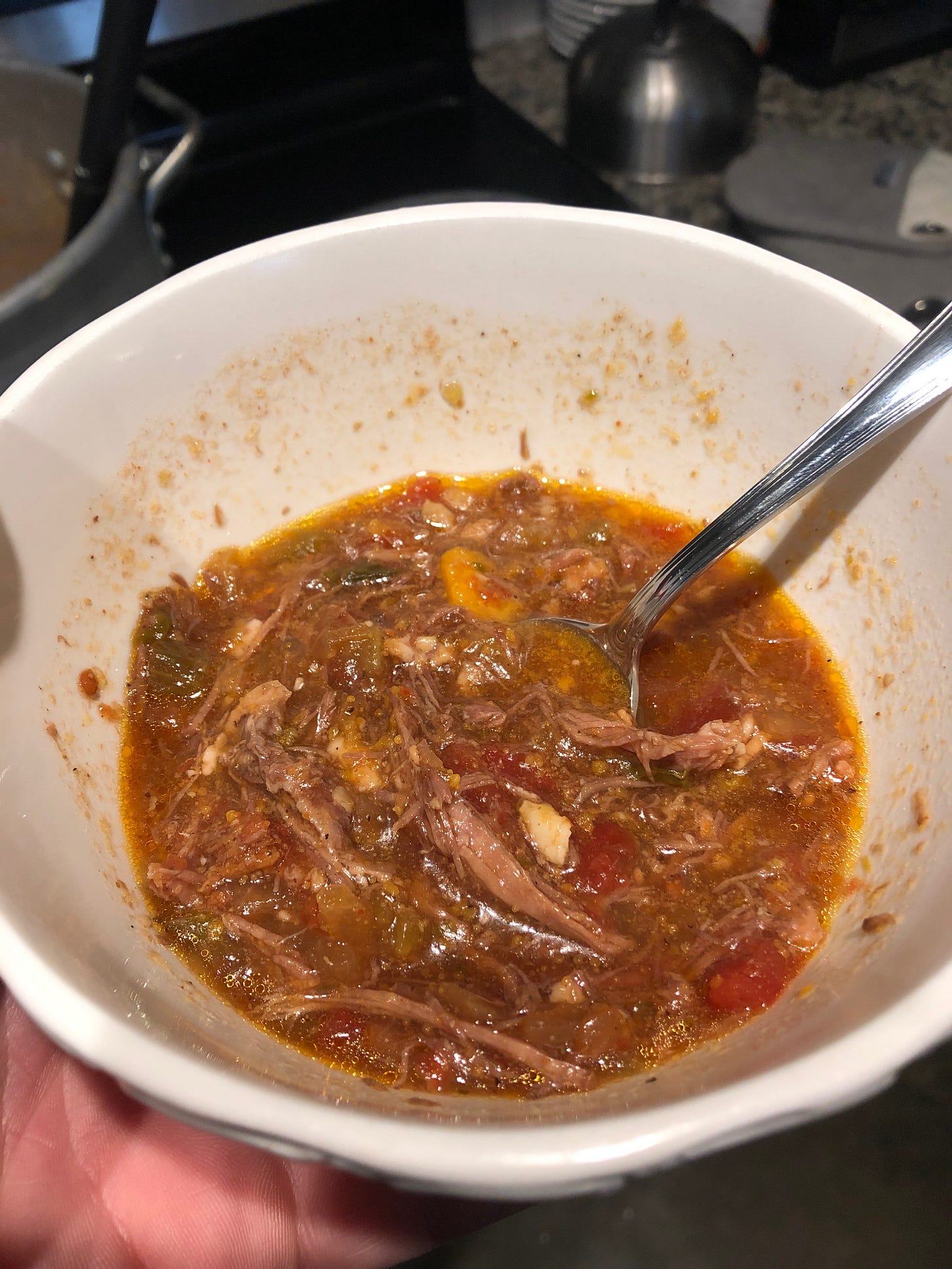Warren Leruth, Culinary Innovator and Powerhouse
A Profile on a Legendary Chef and a Variation of One of His Recipes
Hello, happy Tuesday, and thank you for spending a part of your week with the Gulf Coastal! If you’re reading this in your inbox, thank you for being a subscriber! If this has been forwarded to you, you can subscribe using the button below.
We’re a few weeks into December now and the holidays are in full swing. Houses everywhere have trees and decorations up, radios are playing Christmas music, and men everywhere who are trying to look edgy are claiming that Die Hard is their favorite Christmas movie. I always get nostalgic about my hometown of Gretna, LA, (a.k.a. yet another New Orleans suburb) this time of year, because my fondest December memories all occurred at my grandparents’ house in Old Gretna. Namely, gathering with the extended family on my dad’s side, going Christmas shopping with my mom and grandma (and getting Taco Bell at Oakwood Mall for lunch), and just the general air of conviviality that surrounded it all. Appropriately enough, today’s issue takes me back to my hometown in more ways than one, as it details a version of a recipe that’s been a holiday staple in my family for as long as I can remember that has its origins at a now-shuttered, but fondly remembered Gretna restaurant operated by the late Warren Leruth.
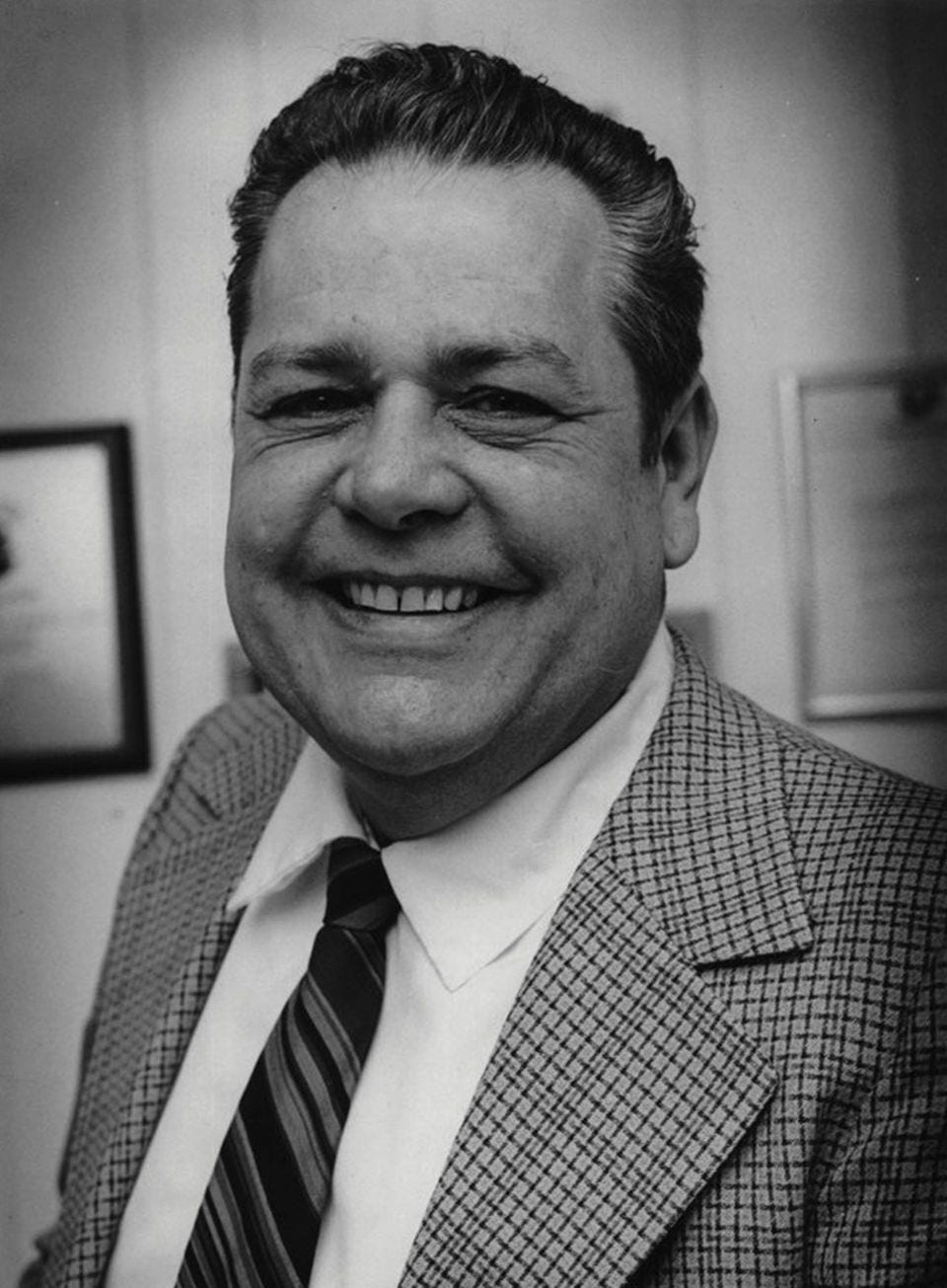
But first, let’s close out last week’s discussion on chili. I made the red chili from last week’s issue this weekend and made two alterations that yielded what I feel is the best pot of chili I’ve made thus far. I used a top sirloin roast and a leftover piece of chuck roast I’d frozen instead of chuck roast exclusively, and instead of browning them in the pot I smoked them for about an hour over a couple of mesquite chunks. The result was a chili that had more depth of flavor and was arguably prettier to look at, as the smoke ring was visible even in the pot and bowl. Otherwise, I followed the recipe as written and it turned out wonderfully.
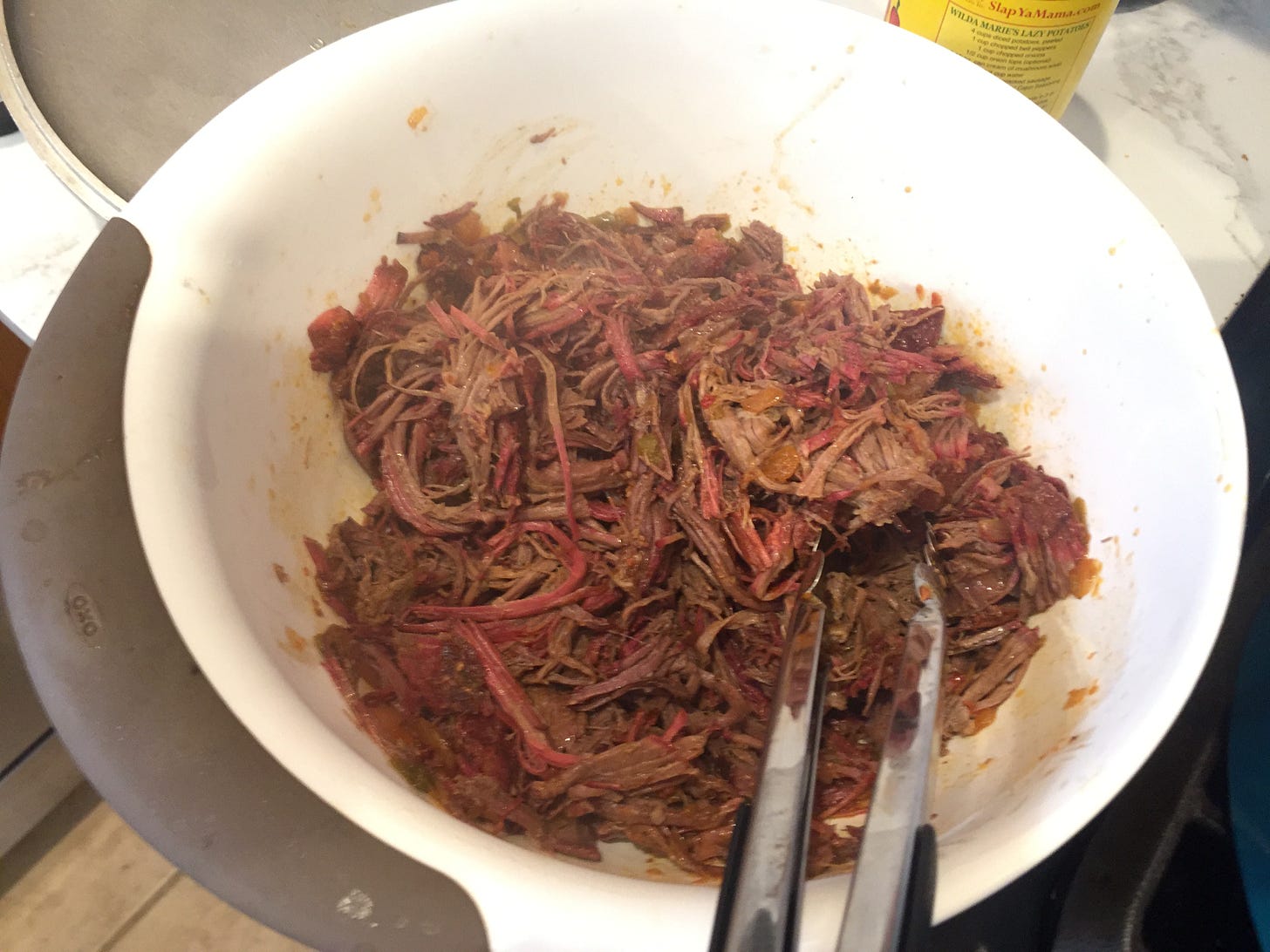
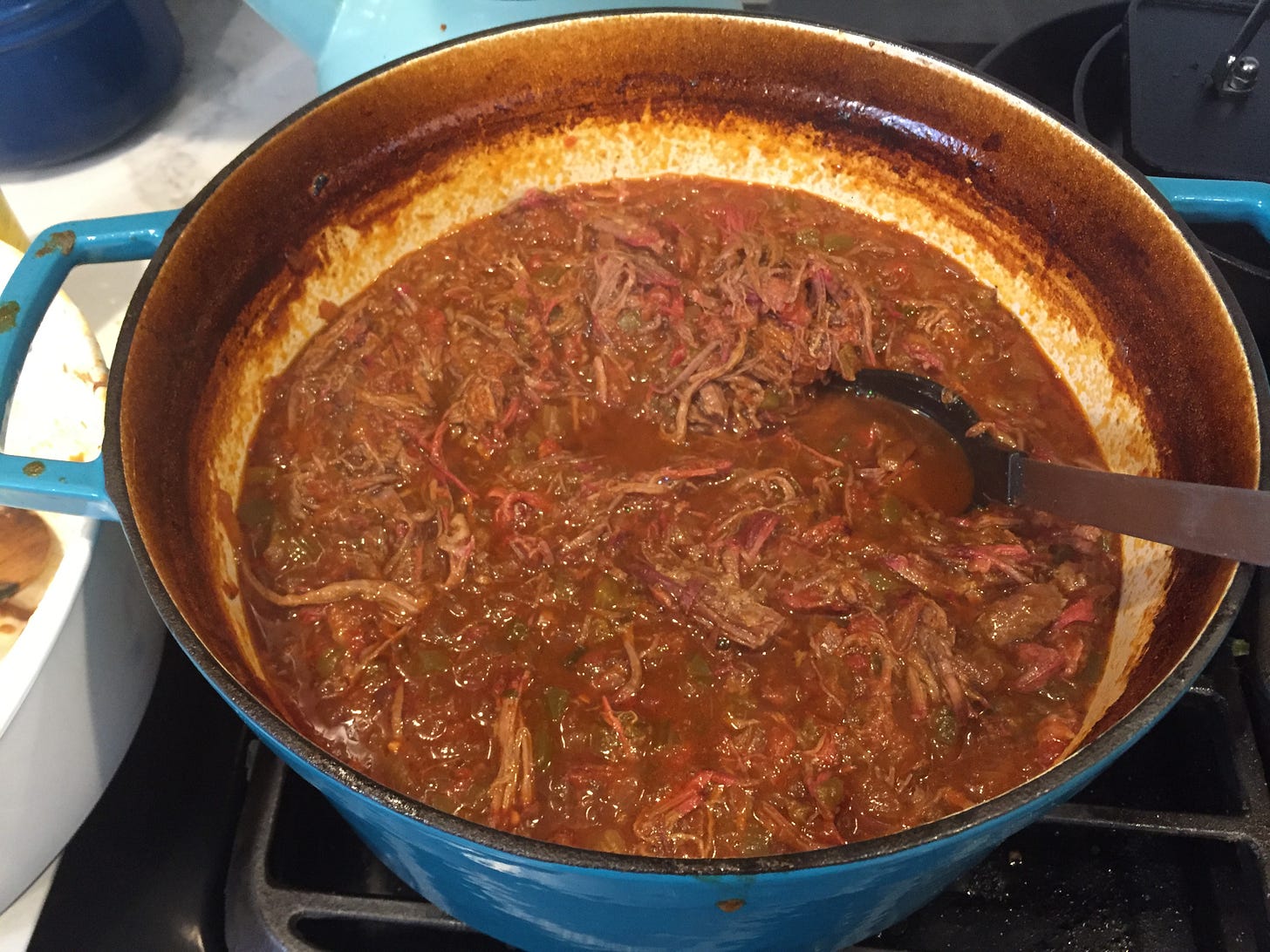
If you have the means to try this, I can’t recommend it enough.
Reader Robby E. added his own spin to this recipe to make a chili for chili cheese dogs, making the following substitutions:
Instead of oil I chopped up some bacon and used that fat to help sear the roast. I wanted more of a sweet-ish chili. Added 14 more ounces of canned tomatoes. And a half quart more beef stock/one more serving of beer because I wanted it to be a bit runny. I guess think Au-Jus instead of gravy. I also used Sriracha ketchup for sweet heat balance but I didn’t measure anything I just squeezed a desirable amount in there for taste around the 3 hour mark.
Thank you for the tips Robby, looks like it turned out great!
Now without further ado, on to the topics of the day: the late, great Warren Leruth and a variation on his oyster artichoke soup (sources not cited in-text in today’s issue can be found at the end of the article), and a brief note on his legacy in both high and “low” cuisine.
The Beginnings of a Culinary Powerhouse
We are currently living in the age of chefs and restauranteurs attaining the status of outright celebrity, not just “celebrity chef.” Anthony Bourdain was the executive chef at Brasserie Les Halles before becoming a renowned author and television host noted for his ability to deliver dispatches about cultures and regions at home and abroad. Emeril Lagasse succeeded Paul Prudhomme (famous in his own right) as executive chef at Commander’s Palace before starting his own restaurant group, hosting his own cooking shows on cable television, and even going on to star in toothpaste commercials. Guy Fieri is a noted good tweeter who has arguably become a cultural icon, carving out a living of self-deprecating humor and leaning into his over the top style, all while rolling out to find America’s greatest diners, drive-ins, and dives.
Others, however, achieved fame simply by being really damn good at what they do. Their cultural impact and influence might not be associated with a television program, cookbook, or broader “brand,” but it might be ever-present without you realizing it. Especially if you’re from South Louisiana, and even if you aren’t.
Enter Warren Leruth.

Leruth was born in New Orleans in 1928 and was a child of the Great Depression. From an early age, he was caught between two potential career paths: wanting to be a scientist or wanting to be a chef. Graduating from Jesuit High School in 1946, the former interest led to him briefly attending LSU in Baton Rouge to study physics before heading back home to apprentice at Solari’s, as well as at Galatoire’s, Diamond Jim Moran’s, and the Hotel Monteleone. Leruth then entered into military service, attending the National Guard’s cooking schools, then serving as a baker, mess hall supervisor, and personal chef for Gen. Mark Clark in the Army.
After leaving the military, Leruth began work for Proctor & Gamble as a bakery serviceman. His scientific bent never quite left him, as he eventually helped develop Duncan-Hines cake mixes for P&G. His experience at P&G allowed him to begin work at Anderson Clayton and Co. as an oil and shortening salesman, then attending their bakery school in 1956, which led to his eventual employment in their research and development wing in Irving, TX. While at Anderson Clayton, Leruth developed Seven Seas salad dressings, and is credited with the names of Thousand Island, Green Goddess, and Creamy Italian dressings.
Eventually, Leruth sought a new outlet for his creative energy. At the behest of Ernest Bertschi, a friend and mentor of Leruth’s who was the executive chef of Restaurant Monsieur Pepe in Dallas, Warren sought financing for his own restaurant in 1962. He secured financing from a local bank and opened the first iteration of LeRuth’s in Sherman, TX.
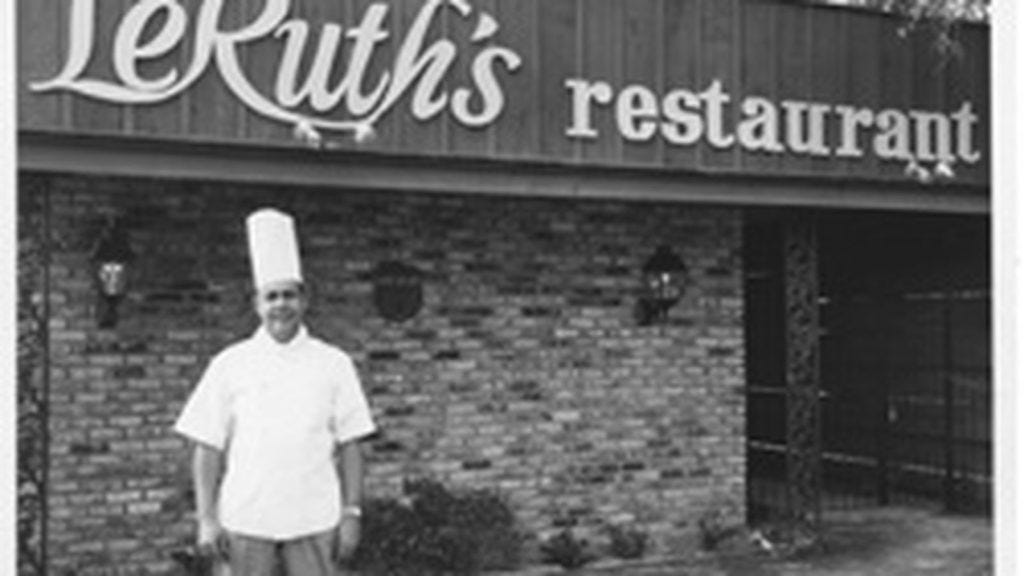
The LeRuth’s of Sherman was a first-class operation with every detail planned out at least 18 months in advance, marrying his culinary skills, meticulous planning, and penchant for military precision into a European-style restaurant that was an instant hit. It opened in May 1963 at 2116 North Highway 75 with a limited menu of Filet Mignon, Filet de Boeuf aux Champignons, and Filet de Truite Amandine. LeRuth’s baked its own bread and prepared its own desserts, uncommon at the time. Within a year of opening his restaurant, Leruth was inducted into the Honorable Order of the Golden Toque at the age of 35. His restaurant’s success led to Leruth overseeing the overhaul of the Woodlawn Country Club’s kitchen. He quickly grew dissatisfied with the country club life, and it eventually led to his desire to depart Sherman and the DFW entirely.
The Scientific Chef in the Cottage on the Westbank

After two years of operation the DFW area, Leruth sold his restaurant in Sherman in 1965 and left Woodlawn to return to New Orleans in the wake of Hurricane Betsy. He eventually opened the second iteration of LeRuth’s in McDonoghville on the Westbank, one of the neighborhoods of Gretna (two women standing at its porch, facing Franklin Street below circa September 1973. Source). LeRuth’s opened on July 10, 1966 at 636 Franklin St. According to a brochure celebrating the restaurant’s 20th anniversary in Tulane’s digital library, reservations were booked within three months of opening. In 1970, Richard Collin published the first edition of the New Orleans Underground Gourmet, hailing LeRuth’s as the best restaurant in the New Orleans area.
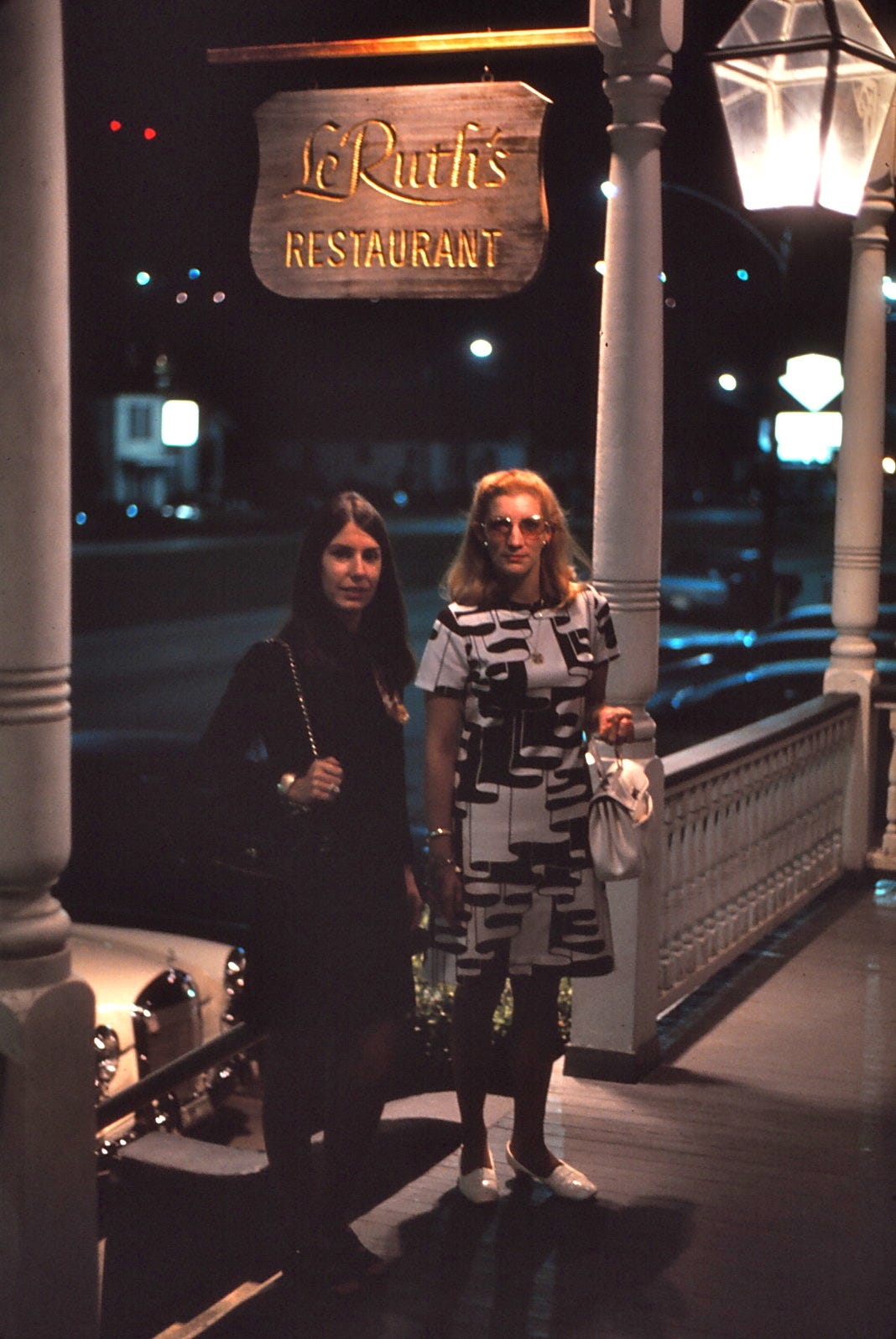
New Orleans food historian Tom Fitzmorris hailed LeRuth’s to be the greatest New Orleans restaurant of all time in 2011, stating that “his baker’s sensibilities carried over into all his recipes,” with cooking times and ingredient amounts being measured to “a degree of exactitude” he has never seen since. Leruth’s scientific sensibilities and acumen yielded recipes that were remarkably consistent and delicious.
And meals at LeRuth’s were meals. Fitzmorris, again:
LeRuth's food lived up to the accolade. It was based on two sources: restaurants in France that Leruth admired, and Galatoire's. Dinner was a five-course table d'hote repast. These were not tasting portions. When you went to LeRuth's, you needed to be ready for a big, lengthy meal (emphasis added).
LeRuth’s may have been difficult to get into, but it was worth the wait (I urge you to read the rest of Fitzmorris’ article, it’s probably the most definitive recounting of LeRuth’s I’ve seen). He served oyster artichoke soup (known as potage LeRuth); canard ferme freres LeRuth - which Fitzmorris describes as “a half duck roasted just right, served atop a smoky stuffing of oysters, herbs, and sausage—a sort of advanced dirty rice—and topped with a peppercorn sauce;” the Chef’s Steak, a 24 oz. prime aged sirloin strip; stuffed trout; frogs legs; racks of lamb with fried parsley; and sweetbreads meuniere. As he did at his restaurant in Sherman, Leruth baked bread and made desserts on-site, including his French vanilla ice cream.
In the process of crafting his menu and restaurant on the Westbank, LeRuth reinvigorated the New Orleans dining scene, which had become pretty staid with menus that were “essentially interchangeable.” It’s kind of hard to imagine anyone saying that about New Orleans in 2019, but the city’s culinary innovation essentially got kicked into high gear because of Warren Leruth’s innovation.
His demand for attention to detail carried over into every aspect of the restaurant, including the waitstaff, who went through daily grooming and hygiene inspections. Leruth wanted things done his way, and when someone is that successful, generally people followed his way. Leruth would even find dissatisfaction in complaining customers who, if unruly enough, found their table surrounded by waitstaff who would then each pick up a corner of the tablecloth and whisk the entire contents of the table away at once in a makeshift sack. “I’ve picked up your check, get out of my restaurant,” was the goodbye they would receive.
Clancy’s owner Brad Hollingsworth, who worked under Leruth’s tutelage in the 1970s, hailed LeRuth’s as a “forerunner to the restaurant renaissance that [New Orleans] experienced in the ‘80s and into the ‘90s.” It was the first restaurant to receive the Mobil five-star rating for five consecutive years. Former Times-Picayune restaurant critic Gene Bourg hailed LeRuth’s as “rewriting the script” of the city’s dining scene. Celebrities like Yul Brynner, Walter Cronkite, and Charles Kuralt were patrons. Andy Rooney featured the restaurant on an episode of 60 Minutes. Leruth sold this iteration of LeRuth’s to his sons Lee and Larry in 1982 (all three pictured below) before it eventually closed in 1991. What follows is a version of one of his signature dishes, oyster artichoke soup.
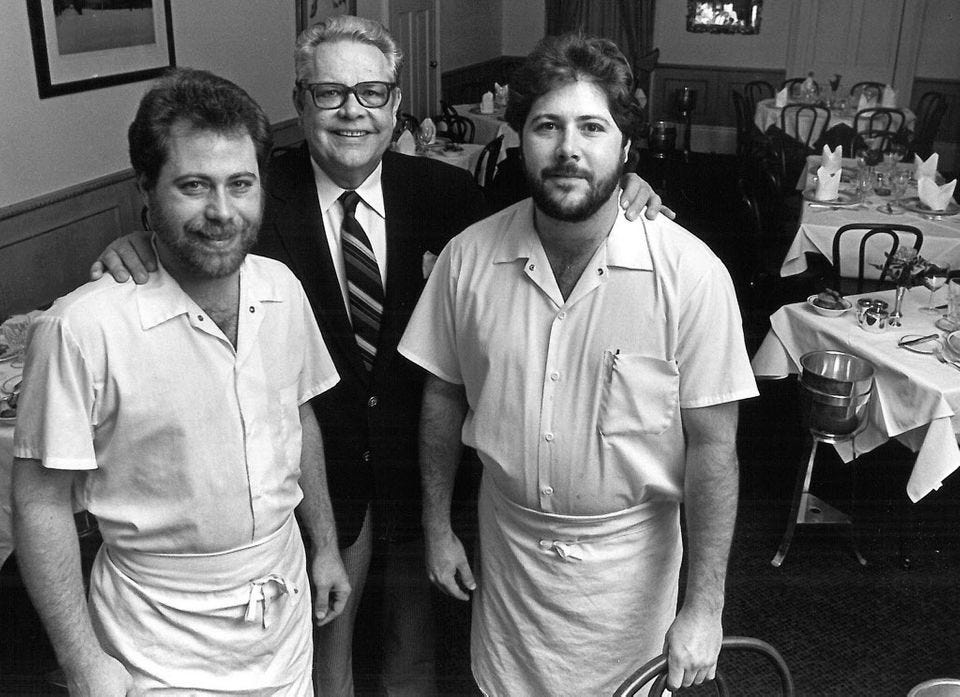
Variations on the Theme of Potage LeRuth
Leruth is noted as the originator of oyster artichoke soup. I searched a while for his recipe before writing this article, I was unsuccessful. Once I did choose a recipe and made my soup, I learned that his recipe did not include cream (the one I used does). There’s quite a few recipes out there for you to try, but this is the one I used. It’s a little heavy because of the cream, but the taste is off the charts between the sweetness of the vegetables and cream and the saltiness of the oysters and oyster liquor. But first, some notes:
Made while listening to the BOWL SEASON PREDICTIONS episode of the Shutdown Fullcast, along with Fog and Bling by Shinyribs, and the playlist from SEC Network series TrueSouth. I highly recommend both the playlist and the show, especially if food and culture of the south interest you in any way
This is my first attempt making oyster artichoke soup and I was worried about how it’d turn out. Honestly? I was pleasantly surprised. The recipe I used (courtesy of Weave a Thousand Flavors) was easy to follow and I basically did so to the letter, which made this easy for a maiden voyage. The only substitution I made was using canned artichokes in lieu of frozen ones, and I halved the ingredients shown below to make a smaller pot for Ali and I, so don’t trust the pictures for ingredient volume when cooking.
List of Ingredients
1 stick - 1/2 cup unsalted butter
1 large yellow onion, (to yield 1-1/2 cups finely chopped)
1 bunch green onions, chopped
2 ribs celery, (to yield 1 cup finely chopped)
4 cloves garlic, peeled
2 13.25 oz. cans of quartered artichokes, drained (and have set some aside to yield roughly 24 oz. total, which is what the recipe requires)
¼ cup all-purpose flour
1 qt. chicken stock
½ tsp Cayenne pepper
1 tsp salt, separated into separate ½ tsps
1 tbs Worcestershire sauce
1/2 tsp fresh thyme or dried thyme in a pinch
2 pints fresh oysters, drained with reserve liquor
1/3 cup sherry
1 cup heavy cream
1 cup milk
Method
Finely chop the yellow onion and celery, crush and chop the garlic, and chop the green onion into circles (honestly I just use scissors for this because I’m lazy)
Heat a dutch oven or similarly heavy-bottomed pot over medium heat, melt the butter, add and saute both the yellow and green onions, celery, ½ tsp salt, and garlic until they soften. It’ll take roughly ten minutes or so.
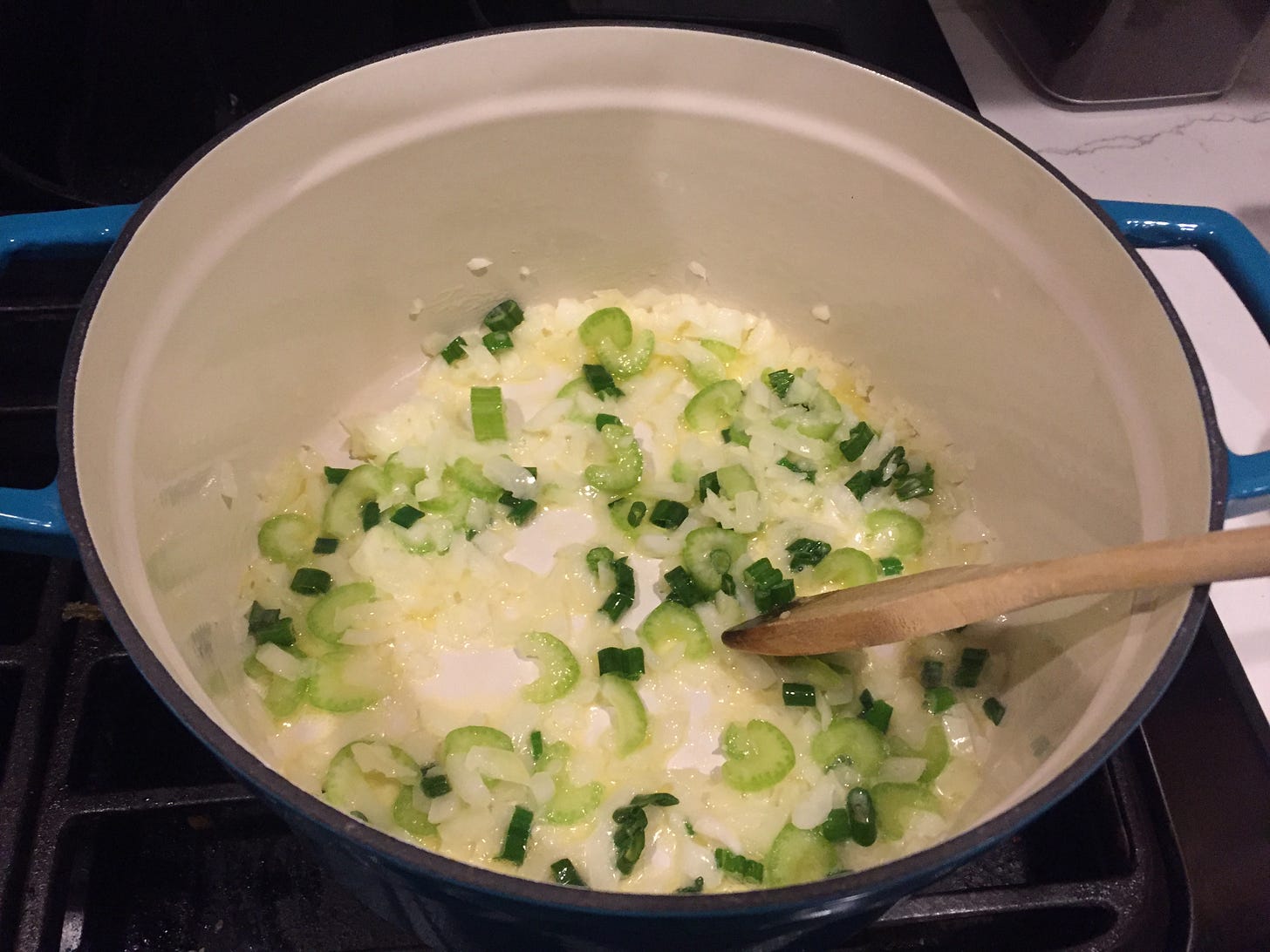
Sprinkle the veggies with the flour and stir to coat well, saute without letting the flour brown. Add in the artichokes and saute for about five minutes.
Add the stock, cayenne, Worcestershire, thyme, and remaining salt.
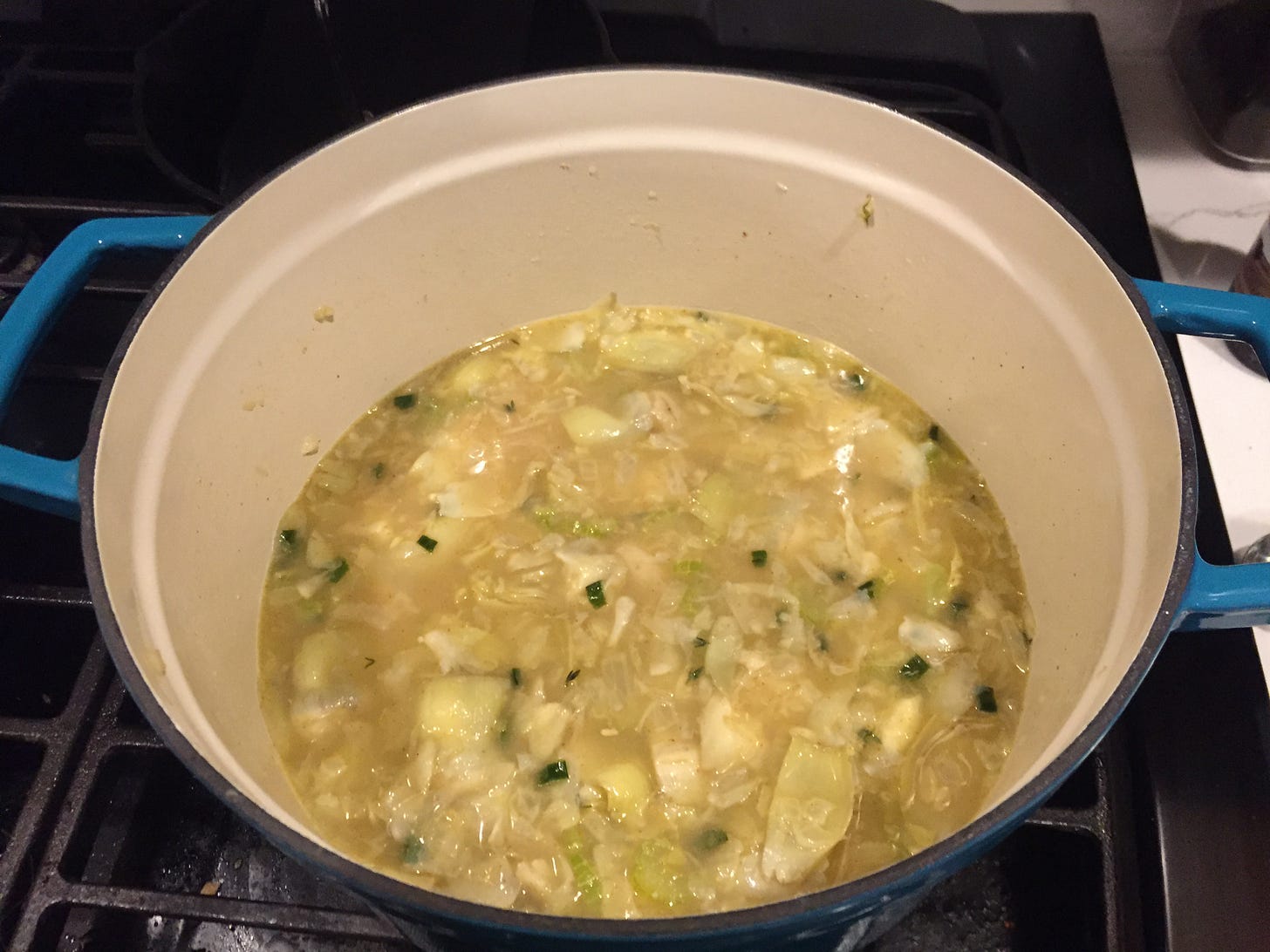
Kick the heat up a bit and bring the soup to a simmer just below boiling, cover with a lid but leave a gap for steam to escape, and let it go for about 45 minutes. Stir to keep the soup from sticking and burning to the bottom of the pot
Separate the oysters from the oyster liquor, then add both of them and the sherry to the pot and simmer for an additional 10 or so minutes. I prefer to add the ingredients individually so I can incorporate them one-by-one
Add the cream and milk and warm through, but do not boil the soup or the Devil will get you
Cool the soup and refrigerate it overnight, or at least 8 hours. Warm it slowly but thoroughly when it’s time to serve without letting it boil. Serve it in a bowl or coffee mug, spoon optional
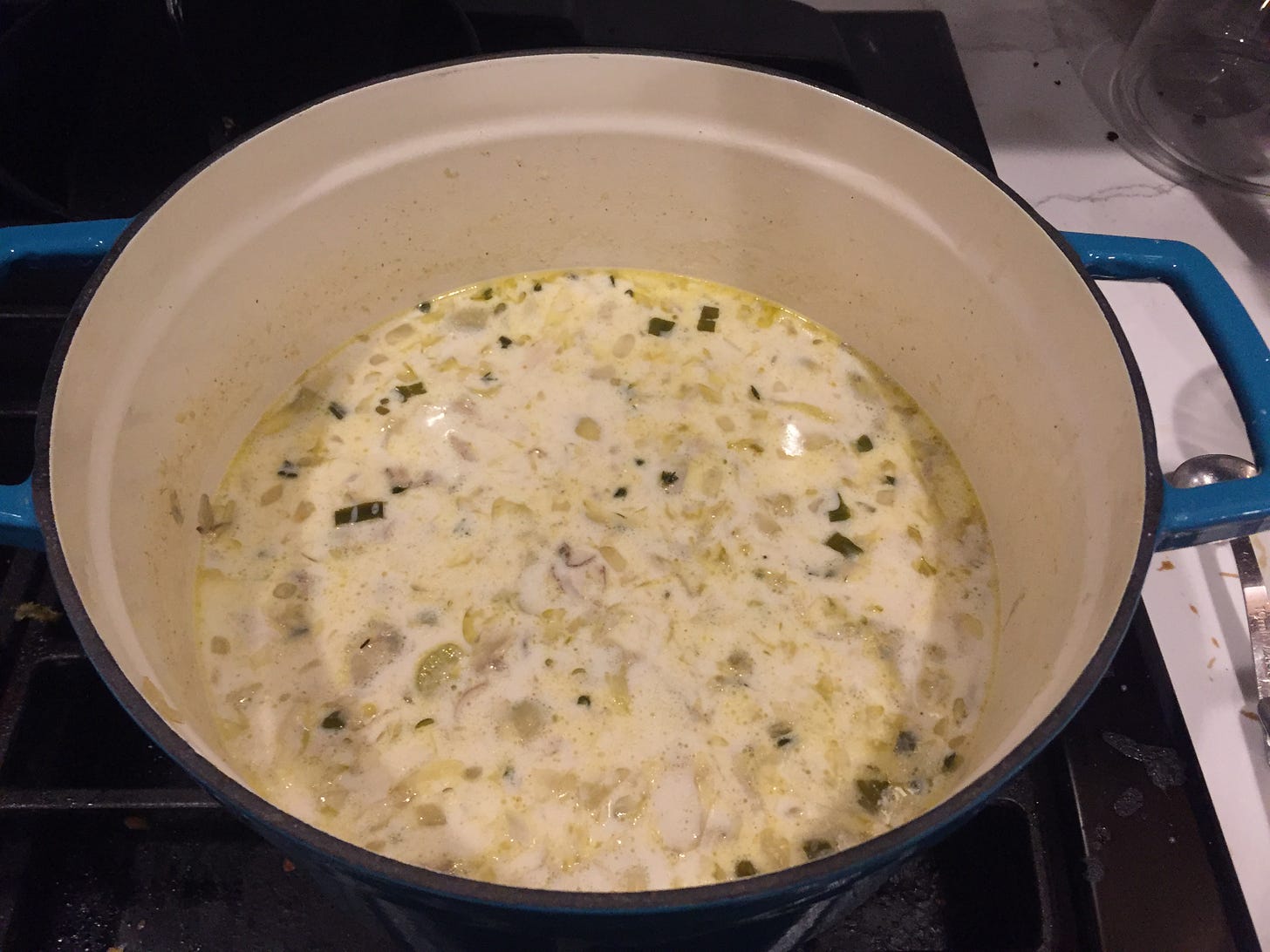
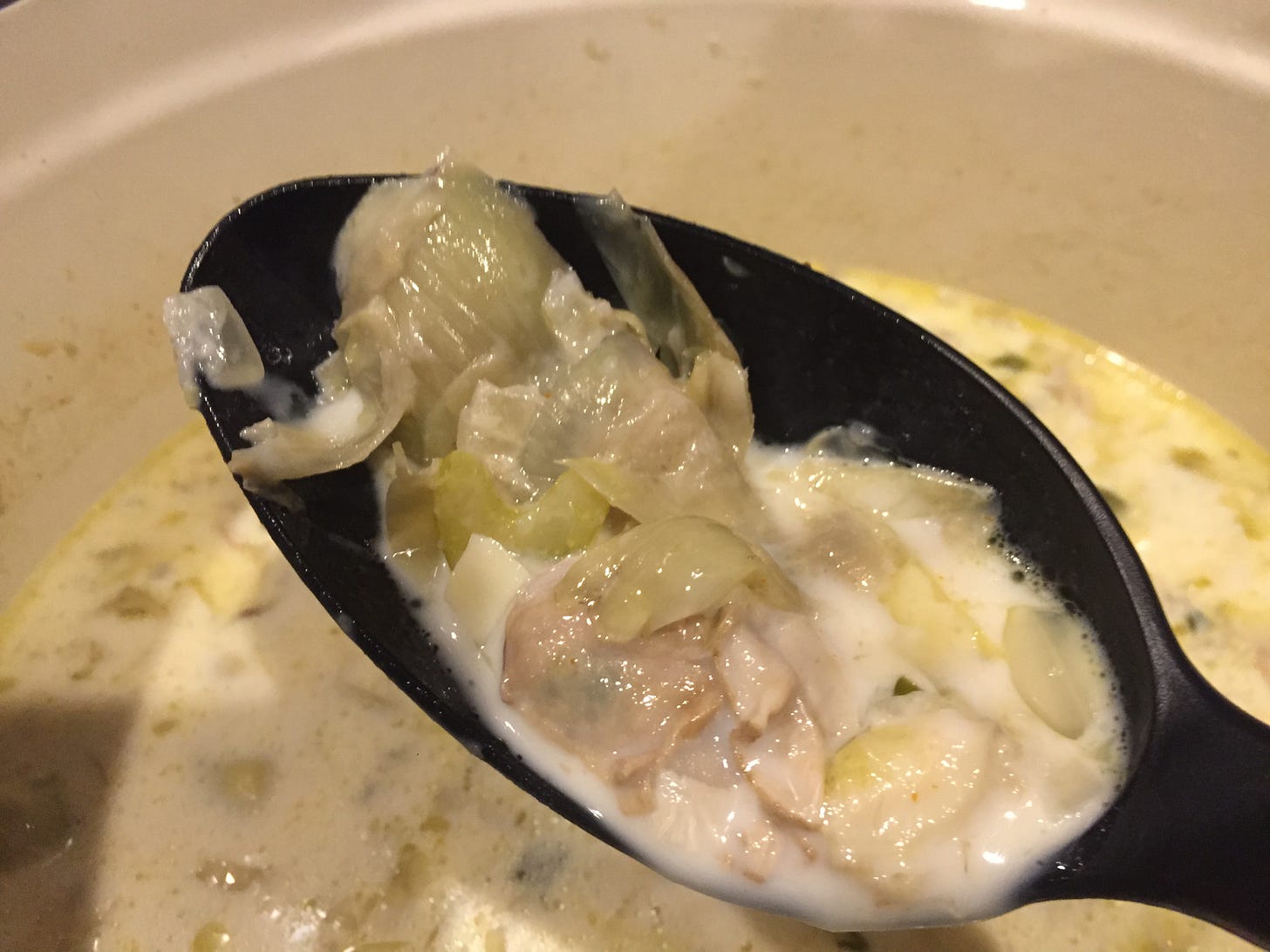
The sweetness and saltiness of this soup feel like a hug in a bowl. It can be used as the first course of a meal, or as part of a meal itself if you like — I like to eat it with a toasted sandwich, but use it how you wish. It’s truly a wonderful dish, and we’re indebted to Warren Leruth for it and his culinary genius.
What Warren Hath Wrought
After selling LeRuth’s in 1982, Warren went back into the test kitchen, creating LeRuth’s and Associates, a food consulting firm. You may have heard of some of his clients: Outback Steakhouse, Krystal, Burger King, and Nestle. While operating his consulting business, Leruth - along with chef Gary Darling - was tapped by Al Copeland (a man known for his subtle and understated manner) to craft recipes for a burgeoning fast-food joint named Popeyes Famous Fried Chicken & Biscuits (you may have heard of it).
Leruth’s contributions? None other than the recipes for Popeyes biscuits, dirty rice, and red beans and rice, which are all served at 3,102 locations in more than 40 states and 30 countries worldwide (see Page 27 of that document). At any given time you’re eating a chain restaurant, you may be tasting a recipe crafted by a bespectacled food scientist with a keen palate somewhere in the New Orleans area.
Sadly, from what I’ve gathered Leruth never produced a true cookbook. Only a few booklets and reproductions of his recipes are available. I presume many were reverse-engineered by chefs throughout the New Orleans area who undoubtedly then added their own spin, so a majority of the true recipes created by the man himself may be lost to time. He passed away in 2001 at the age of 72, leaving a legacy of changing how and what we eat that runs the gamut from haûte cuisine to your average fast-food order. While he may not have had the mass-media appeal of the celebrity chefs of today, Warren Leruth is no less influential, and he was a true innovator whose legacy will last generations.
Thank you for reading the Gulf Coastal. If you have any thoughts, comments, or suggestions, feel free to send them to me at rauzachary@gmail.com. Research sources from today’s issue are below. And if you like the newsletter please tell anyone you can, any way you can. You can even share using the button below. Have a good day and rest of your week!
Note on Sources from Today’s Issue
Brett Anderson, Restauranteur Warren Leruth Dies at Age 72 - NOLA.com
Brian Boyles, Hot Biscuits - 64 Parishes
Tom Fitzmorris, LeRuth’s - NOMenu.com
GreatChefs.com, Warren Leruth (1928-2001)
Patty Macsisak, Warren Leruth: Genius in the Kitchen - Texoma Living
Todd A. Price, When Warren Leruth Changed New Orleans Cuisine - NOLA.com
Rouses Markets, Leruth’s Legacy

